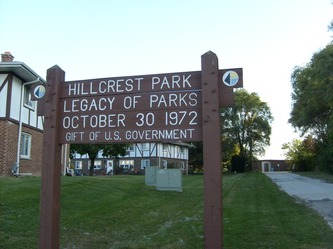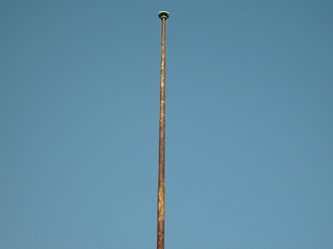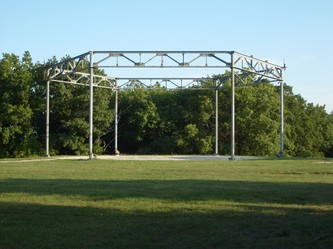M-74 Nike Missile Site
Waukesha, Wisconsin
Nike Missile bases first appeared on the Milwaukee landscape in 1956 (some sources say 1955) and departed in 1971. One of the Milwaukee Nike bases, M-74, is featured here.
In operation from 1956 to 1971, the Nike Missile site in Waukesha, WI, designated M-74, was one of eight missile sites that surrounded Milwaukee, Wisconsin. The missile sites were designed to protect urban areas from enemy bomber attack during the Cold War.
In operation from 1956 to 1971, the Nike Missile site in Waukesha, WI, designated M-74, was one of eight missile sites that surrounded Milwaukee, Wisconsin. The missile sites were designed to protect urban areas from enemy bomber attack during the Cold War.

Some notes about Waukesha Nike Missile Base M-74 are as follows:
- * Of the eight Milwaukee-area Nike missile sites, M-74 was one of only two (the other being the River Hills site on Brown Deer Road) to be in operation for the entire 1956 - 71 time-frame. The other six Milwaukee missile sites had been shut down in years prior to 1971.
- * It was one of three Milwaukee-area Nike sites to be converted from the Ajax to the more-advanced Hercules missile. The conversion for site M-74 took place in August 1959. Initially, all eight Milwaukee-area sites carried the Ajax missile. The five sites that were not converted to the Hercules were all shut down by 1964.
- * Active Army personnel operated site M-74 from 1956 - 1964. The Wisconsin National Guard took over operations in June 1964 and manned the site until its closure in 1971.
- * In August 1964, the Wisconsin National Guard unit stationed at M-74 was one of two units nationwide that was awarded a trophy for the air defense command's best firing batteries.
- * Nike missile site M-74, along with the River Hills facility, was closed in June 1971, leaving the Milwaukee area with no surface-to-air missile sites. (The third Nike Hercules site, located on Milwaukee's lakefront, had been closed in 1969.) Milwaukee airspace was to be defended by missile facilities from Chicago and Minneapolis. Eventually, all Nike missile sites nationwide were shut down.
The M-74 Areas

M-74 Nike Missile Base, Waukesha, WI
The M-74 missile site, like most other Nike missile sites, was located on two parcels of land: One was the Integrated Fire Control (IFC) area, the other being the launcher area. For this particular missile base, the launcher area was one mile south of the IFC area.
The IFC area is where the ground-based radars and computers were located; it was designed to detect and track enemy aircraft. The top marker on the map at left shows where the M-74 IFC area was located.
The second parcel of land is the launcher area. This is where the Nike missiles were stored and, if need be, fired from. The bottom marker on the map shows where the M-74 launcher area was located.
Note: For most Nike missile bases, the IFC area was located between the launcher area and the urban area that the base was design to protect. However, that was not the case for Nike base M-74: The launcher area was located one mile south of the the IFC area, while Milwaukee was east of both the IFC and launcher areas. The IFC was not located between the launcher area and Milwaukee.
For a more in-depth overview of the Nike Air Defense Missile, visit TheMilitaryStandard-Nike
The IFC area is where the ground-based radars and computers were located; it was designed to detect and track enemy aircraft. The top marker on the map at left shows where the M-74 IFC area was located.
The second parcel of land is the launcher area. This is where the Nike missiles were stored and, if need be, fired from. The bottom marker on the map shows where the M-74 launcher area was located.
Note: For most Nike missile bases, the IFC area was located between the launcher area and the urban area that the base was design to protect. However, that was not the case for Nike base M-74: The launcher area was located one mile south of the the IFC area, while Milwaukee was east of both the IFC and launcher areas. The IFC was not located between the launcher area and Milwaukee.
For a more in-depth overview of the Nike Air Defense Missile, visit TheMilitaryStandard-Nike
The M-74 IFC Area

Today, the M-74 IFC area is known as Hillcrest Park, located in Waukesha, WI. The satellite view of the park at left shows the mess hall, radar towers, blast building, and barracks. The city of Waukesha added the water tank after the missile base was closed.
The photos below were taken in 2009. Click on the photos to enlarge
Left: Entrance to Hillcrest Park, which was the location of the IFC for the M-74 Nike missile base. The mess hall can barely be seen at the end of the driveway.
Center: Dedication marker inside the park from U.S. Army Servicemen who served at the missile base. The U.S. Army operated the site from 1956 - 64. In 1964, the Wisconsin National Guard took over and manned the base until its closure in 1971.
Right: View from the park. This photo shows that the IFC was located on a piece of land that was higher than the surrounding area. Whenever possible, control areas were constructed on high ground in order to gain superior radar coverage of the area.
Center: Dedication marker inside the park from U.S. Army Servicemen who served at the missile base. The U.S. Army operated the site from 1956 - 64. In 1964, the Wisconsin National Guard took over and manned the base until its closure in 1971.
Right: View from the park. This photo shows that the IFC was located on a piece of land that was higher than the surrounding area. Whenever possible, control areas were constructed on high ground in order to gain superior radar coverage of the area.
Left: Foreground is the pad where the barracks formerly stood. The mess hall is in the background.
Center: Dedication marker, flag pole, and mess hall.
Right: Flag pole.
Center: Dedication marker, flag pole, and mess hall.
Right: Flag pole.
Left: Pad where barracks once stood.
Center: The radar towers.
Right: The radar towers in the background; the blast building is on the right.
Center: The radar towers.
Right: The radar towers in the background; the blast building is on the right.
The radar towers.
Left: The radar towers are in the foreground; the blast building is behind them. Behind the blast building is a circular water reservoir, which was built after the missile base was closed.
Center: Barracks pads in foreground; radar towers and blast building in background. Further back is the circular water reservoir and apartment buildings, neither of which were around when the base was active.
Right: Blast building at the end.
Center: Barracks pads in foreground; radar towers and blast building in background. Further back is the circular water reservoir and apartment buildings, neither of which were around when the base was active.
Right: Blast building at the end.
The M-74 Launcher Area

After the missile base was closed, the launcher parcel area was given to the city of Waukesha and named Missile Park. The park sign pictured at left is no longer there, likely removed when the Waukesha mayor ordered the park closed to the public in September 1983, due to the area becoming an illegal dumping ground.
Perhaps the most interesting thing to see at this time (2009) is an old guard shack next to the entrance. Supposedly the underground magazines are still there but are buried under concrete slabs and piles of wood chips.
Perhaps the most interesting thing to see at this time (2009) is an old guard shack next to the entrance. Supposedly the underground magazines are still there but are buried under concrete slabs and piles of wood chips.
Left: Guard shack next to the entrance.
Left center: Entrance to the launch site. The guard shack (not in photo) is to the left of the entrance.
Right center: Old light located on the road to the launch site.
Far right: Approximately 300 feet past the gate on way to launch site.
Left center: Entrance to the launch site. The guard shack (not in photo) is to the left of the entrance.
Right center: Old light located on the road to the launch site.
Far right: Approximately 300 feet past the gate on way to launch site.
The underground magazines are supposedly beneath the piles of wood chips.
For more information about Nike Missile Base M-74, click here






















